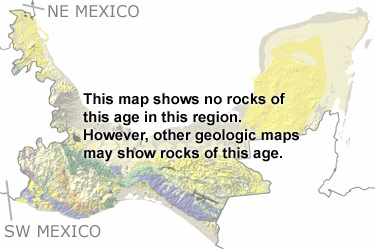Paleontology and geologyIn the Permian, Gondwana collided with Laurentia to form the supercontinent Pangea. This collision brought older rocks in the western part of this region to their present position and pushed rocks of the Yucatan Peninsula up against the ancient southeastern United States. Volcanoes and large masses of granite formed from the heat and pressure generated by the collision. Some areas were pushed up and others dropped down into basins. Shallow to deep seas filled the basins and extended down a steep slope in the west to the open ocean. These seas were home to corals, sponges, brachiopods, bivalves, bryozoans, foraminifera, gastropods, cephalopods, and sharks. Many Permian rocks have been eroded or buried. The remaining exposures are too small to appear on this map, but they may be be shown on the map of undifferentiated Paleozoic rocks or on other more detailed maps. |


